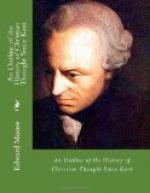The Andover address consisted in the statement of Bushnell’s views of the causes which had led to the schism in the New England Church. A single quotation may give the key-note of the discourse:—’We had on our side an article of the creed which asserted a metaphysical trinity. That made the assertion of the metaphysical unity inevitable and desirable. We had theories of atonement, of depravity, of original sin, which required the appearance of antagonistic theories. On our side, theological culture was so limited that we took what was really only our own opinion for the unalterable truth of God. On the other side, it was so limited that men, perceiving the insufficiency of dogma, took the opposite contention with the same seriousness and totality of conviction. They asserted liberty, as indeed they must, to vindicate their revolt. They produced, meantime, the most intensely human and, in that sense, the most intensely opinionated religion ever invented.’
THE CATHOLIC REVIVAL
The Oxford Movement has been spoken of as a reaction against the so-called Oriel Movement, a conservative tendency over against an intellectualist and progressive one. In a measure the personal animosities within the Oxford circle may be accounted for in this way. The Tractarian Movement, however, which issued, on the one hand, in the going over of Newman to the Church of Rome and, on the other, in a great revival of Catholic principles within the Anglican Church itself, stands in a far larger setting. It was not merely an English or insular movement. It was a wave from a continental flood. On its own showing it was not merely an ecclesiastical movement. It had political and social aims as well. There was a universal European reaction against the Enlightenment and the Revolution. That reaction was not simple, but complex. It was a revolt of the conservative spirit from the new ideals which had been suddenly translated into portentous realities. It was marked everywhere by hatred of the eighteenth century with all its ways and works. On the one side we have the revolutionary thesis, the rights of man, the authority of reason, the watchwords liberty, equality, fraternity. On the other side stood forth those who were prepared to assert the meaning of community, the continuity of history, spiritual as well as civil authority as the basis of order, and order as the condition of the highest good. In literature the tendency appears as romanticism, in politics as legitimism, in religion as ultramontanism. Le Maistre with his L’Eglise gallicane du Pape; Chateaubriand with his Genie du Christianisme; Lamennais with his Essai sur l’Indifference en Matiere, de Religion, were, from 1820 to 1860, the exponents of a view which has had prodigious consequences for France and Italy. The romantic movement arose outside of Catholicism. It was impersonated in Herder. Friedrich Schlegel, Werner and others




